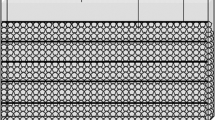Abstract
Glass microscope slides were submerged for two to six week periods at selected sites in a small, spring-fed stream near Lennoxville, Quebec. Slides were oriented parallel and perpendicular to the current. Qualitative and quantitative data from transects across slides show that diatoms are randomly distributed on slides perpendicular to the current but not on slides oriented parallel to the current. In the later case, most individuals first settled near the upstream or downstream edge of the slide. Non-random distribution is most pronounced on slides containing Cocconeis placentula. This species and two others, Achnanthes linearis and A. minutissima, are abundant and determine most distribution patterns found on slides. Preference of diatoms for the edges of slides appears to be affected by current. We propose a model, based upon water flow, to explain the preferential distribution of diatoms on slides oriented parallel to the current. Light appears not to affect settling patterns to a great extent in this study.
Similar content being viewed by others
References
Blum, J. L., 1960. Algal populations in flowing waters. Spec. Publs. Pymatuning Lab. Fld. Biol. Vol. 2: 11–21.
Butcher, R. W., 1947. Studies on the ecology of river, VII. The algae of organically enriched waters. J. Ecol., 35: 186–191.
Cattaneo, A., 1978. The microdistribution of epiphytes on the leaves of natural and artificial macrophytes. Br. Phycol. J., 13: 183–188.
Cattaneo, A., Ghittori, S. & Vendegna, V., 1975. The development of benthic phytocoenoses on artificial substrates in the Ticino River. Oecologia (Berl.), 19: 315–327.
Conover, W. J., 1971. Practical non-parametric statistics. John Wiley & Sons Inc., N.Y. 462 pp.
Douglas, B., 1958. The ecology of attached diatoms and other algae in a small stony stream. J. Ecol., 46: 295–322.
Düringer, I., 1958. Über die Verteilung epiphytischer Algen auf den Blättern Wasserbewohnender Angiospermen. Öst. Bot. Z., 105: 1–43.
Eddy, S., 1934. A study of freshwater plankton communities. Illinois biol. Monogr., 12: 1–93.
Eloranta, P. & S. Kunnas, 1979. The growth and species communities of the attached algae in a river system in Central Finland. Arch. Hydrobiol. 86: 27–44.
Evans, H. L., 1968. Laminar Boundary-Layer Theory. Addison-Wesley Pub. Co.
Fjerdingstad, E., 1964. Pollution of streams estimated by benthal phytomicro-organisms. I. A saprobic system based on communities of organisms and ecological factors. Int. Rev. Ges. Hydrobiol. 49(1): 63–131.
Fritsch, F. E., 1929. The encrusting algal communities of certain fast flowing streams. New Phytol. 28(3): 165–196.
Gessner, F., 1953. Die Limnologie des Naturschutzgebietes Seeon. Arch. Hydrobiol., 47(4): 553–624.
Godward, M. B., 1934. An investigation of the causual distribution of algal epiphytes, Beih. Bot. Zbl., 52: 506–539.
Godward, M. B., 1937. An ecological and taxonomic investigation of the littoral algal flora of Lake Windermere. J. Ecol., 25: 496–568.
Hansmann, E. & Phinney, H., 1973. Effects of logging on periphyton in coastal streams in Oregon. Ecology, 54(1): 195–199.
Hinze, J. O., 1975. Turbulence, 2nd ed. McGraw-Hill, Inc. New York.
Hynes, H. B. N., 1970. The ecology of running waters. Univ. of Toronto Press, Toronto.
Jaag, O. & Ambuhl, H., 1963. The effect of current on the composition of biocoenoses in flowing water streams. Int. J. Air. Wat. Poll. Pergamon Press, vol. 7, pp. 317–330.
Patrick, R., 1949. A proposed biological measure of stream conditions based on a survey of the Conestoga Basin, Lancaster County, Pennsylvania. Proc. Ac. Nat. Sc. Phil., 101: 277–341.
Patrick, R., Hohn, M. & Wallace, J., 1954. A new method for determining the pattern of the diatom flora. Notul. Nat. Acad. Phil., #259: 1–12.
Patrick, R. & Reimer, C., 1966. The diatoms of the United States. Monographs Acad. Natur. Sci. Phil., Vols. I, II.
Round, F. F., 1965. The biology of algae. Edward Arnold Ltd., London.
Whitford, L. A., 1960. The current effect and growth of freshwater algae. Trans. Amer. Micros. Soc., 79(3): 302–309.
Whitford, L. A. & G. J. Schumacher, 1961. Effect of current on mineral uptake and respiration by a freshwater alga. Limnol. Oceanogr. 6: 423–425.
Whitford, L. A., 1964. Effect of current on respiration and mineral uptake in Spirogyra and Oedogonium. Ecology., 45: 168–170.
Whiller, A., 1922. Der Aufwuchs der Unterwasserpflanzen. Verh. int. Verein Limnol., 1: 37–57.
Author information
Authors and Affiliations
Rights and permissions
About this article
Cite this article
Munteanu, N., Maly, E.J. The effect of current on the distribution of diatoms settling on submerged glass slides. Hydrobiologia 78, 273–282 (1981). https://doi.org/10.1007/BF00008524
Received:
Issue Date:
DOI: https://doi.org/10.1007/BF00008524




